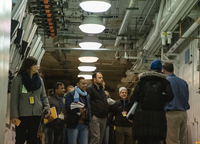NSTC HOSTS IAEA ITC-28
The three-week session provided 59 participants from 40 countries with the knowledge and practical skills to effectively define, design, and evaluate physical protection systems that protect against the unauthorized removal of nuclear materials and sabotage of nuclear facilities.
The course involves both classroom training and hands-on exercises. Some of these exercises are held at Sandia’s Integrated Security Facility (ISF), which was originally designed to protect Category I nuclear material, but now serves as a venue for advanced training and in-depth testing and evaluation of security systems. With its fully functional security systems, ISF is invaluable for demonstrating the operational and technical elements required for effective physical security, including physical protection, Nuclear Materials Accounting & Controls, response, transport security, sabotage, insider threat, cybersecurity, drills and exercises, and national level infrastructure.
During the final week of the course, participants divided into sub-groups to design a security system for one of three hypothetical nuclear facilities—a nuclear power plant, a Category II nuclear material research reactor, and a small modular reactor—and then tested that design with various evaluation tools. The sub-groups also created adversary scenarios and conducted a tabletop exercise that included an attempted act of sabotage. For the first time, the sub-groups used Scribe3D©, a new software tool that documents the exercise and provides real-world context. The course concluded with international speakers from the IAEA and presentations from each of the sub-groups on their findings.
Noting the long history of collaboration between the IAEA, NNSA, and Sandia National Laboratories, Muhammad Khaliq, Head of Nuclear Security of Materials and Facilities Section of the IAEA’s Division of Nuclear Security, says, “We continuously update the course materials to reflect the needs of the Member States. This time, we have included new modules on security for small modular reactors and information about insider threats. The ITC continues to be our flagship course on physical security.”
“Our participants come from a wide variety of backgrounds—some work in operational areas at nuclear power plants or research reactors, some are regulators or policy makers,” says Gregory Baum (6812), ITC Course Director. “Beyond the training, ITC gives them the opportunity to form professional connections and build a stronger international community of practice.”
The ITC has been held every 18 months since 1978 and has provided training on international best practices for physical protection of nuclear material and nuclear facilities to more than 1000 participants from more than 70 countries.
View a video interview of previous ITC participants in the Video Library.
